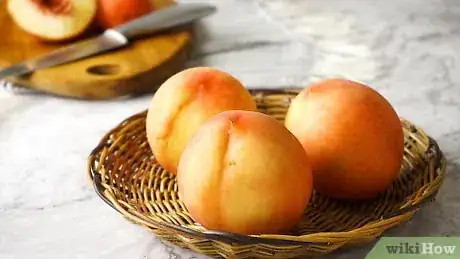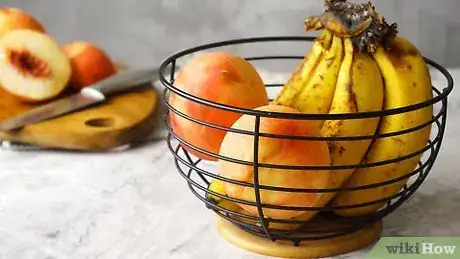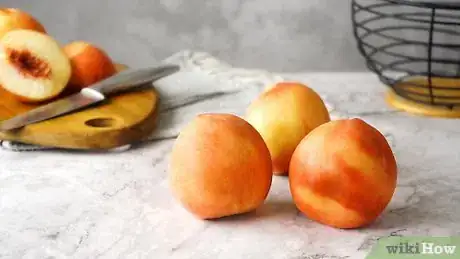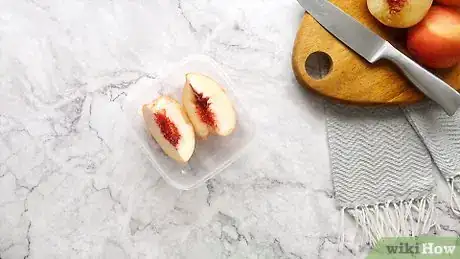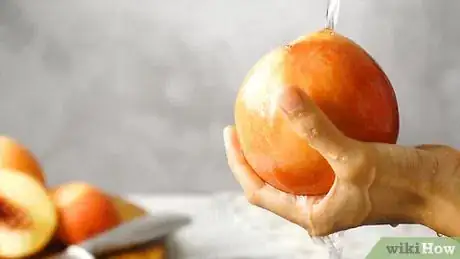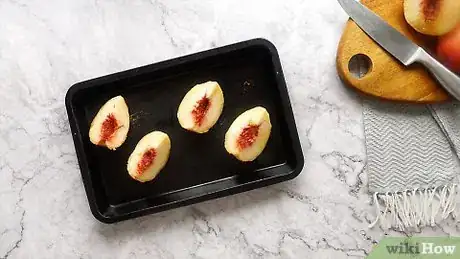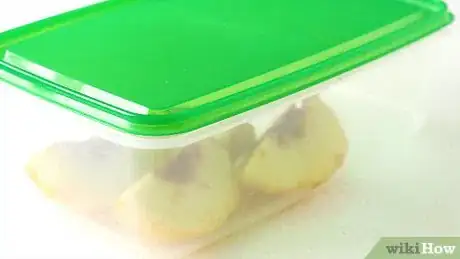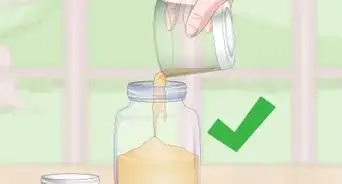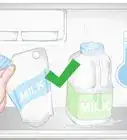This article was co-authored by Jerran Boyer. Chef Jerran Boyer is a Nutrition-Focused Professional Chef and the CEO of Health Nut Chefs. Chef Jerran has over 20 years of experience as a private chef. She and her team specialize in providing healthy, fresh-prepared meals designed with each client’s taste and dietary needs in mind. She and her team offer both personal, part-time chef services and private, full-time chef services in New York, New Jersey, and the Los Angeles area. Chef Jerran received her BS in Business Administration from the University of South Florida, a degree in Culinary Arts from Florida Culinary Institute, and a Plant-Based Nutrition Certificate through Cornell University.
There are 7 references cited in this article, which can be found at the bottom of the page.
This article has been viewed 58,224 times.
Summer time and the peaches are plentiful! When you have fresh produce, chances are you’ll want to store it safely until you’re ready to consume it. With peaches, there are a few different ways you can store them, depending on whether or not they are ripe and whether you’re looking to freeze them or simply keep them in the fridge for a few days. By learning how to properly clean, prepare, and store your peaches, you can give yourself a slightly bigger window in which you can enjoy them before they go bad.
Steps
Storing Unripe Peaches
-
1Test your peaches for ripeness. Look to see if they have a yellow or gold tint beneath the reddish blush of the peach. Squeeze them gently—they should feel firm, yet soft. Smell the peaches—they should have a strong, sweet fragrance; unripe peaches will have a more muted fragrance.[1]
- Unripe peaches will feel hard, and mushy peaches are overripe.
- Unripe peaches should be stored separately from ripe peaches, and the proper storage method will vary based on how ripe a peach is.
-
2Place your peaches on the counter for a few days to help them ripen. You can place them in sunlight, but keep an eye on them every day to make sure they aren’t getting too hot, which in turn can make them mushy. Leave your unripe peaches on the counter for 2-3 days, or until they have a slight give when you grasp them.[2]
- Don’t store unripe peaches in the fridge. This can change the consistency, coloring, and flavor of the peach in an undesirable way.
Advertisement -
3Put your peaches in a brown paper bag to ripen them more quickly. Simply pop 1 or 2 peaches into a brown paper bag and leave them on the counter for 1-3 days. Check the peaches every day to make sure you don’t miss the window of ripeness before they turn mushy.[3]
- If you have more than 2 peaches, use more than 1 brown paper bag to make sure they don’t get squished together.
-
4Place a banana or an apple near your peaches to ripen them faster. Whether they’re on the counter or in a brown paper bag, you can simply place a piece of fruit, like a banana or an apple or even an avocado, near the peaches to help speed up the ripening process. Check your peaches every day to make sure they aren’t getting mushy. This process takes 1-2 days.[4]
- Peaches, bananas, and apples all emit a gas called ethylene gas, which helps them get ripe, so putting together those fruits helps them get riper faster than they would on their own.
-
5Store your peaches on their shoulders (the side where the stem is). Whether you are putting your peaches into a bag, a bowl, or on the counter, place them stem-side down to limit the amount of contact they have with a hard surface.[5]
- Peaches stored on their shoulders are also less likely to accidentally roll and fall off the counter.
-
6Leave space between the peaches so they don’t get bruised. Peaches like to breathe and are less likely to get mushy if they aren’t pressed up against one another. If you are going to stack them in something like a bowl, try to not stack them too deep, as the weight will bruise the peaches on the bottom. If you can, it’s best to line up the peaches on the counter with a little bit of space between each one.[6]
- Similarly, if you’re storing your peaches along with other fruits on the counter, avoid putting the peaches on the bottom. If you have to stack them, keep them on the top.
Keeping Peaches in the Fridge
-
1Rinse the peaches to clean off any dirt or debris. Simply run the peaches under the water in your sink and run your hands over the fruit a few times to dislodge any dirt. You shouldn’t have to scrub or rinse them for very long.[7]
- If you don’t like the taste and texture of peach “fuzz,” you can gently rub most of it off with your fingers while you rinse the fruit. Don’t use a scrub brush as it can damage the flesh of the fruit.
-
2Dry the peaches with clean paper towels or a clean hand towel. Take care to not squeeze and bruise the peaches while you are drying them. Just rub the fruit with the dry towel until there is no more moisture caught up in the peach fuzz.[8]
- Drying the peaches before storing them is an important step, as the moisture can damage the skin of the peach once it gets cold in the fridge.
-
3Place whole, uncut peaches in the fridge on their own or in a plastic bag. If you’re going to be eating your peaches whole or using them soon for a recipe, you can simply place them in the fridge and store them in there for 2-3 days. If you’re putting them into a bag, make sure to not stuff too many into 1 container, to reduce the risk of bruising.[9]
- The cool temperature in your fridge slows down the ripening process, which gives you a few extra days to enjoy your peaches.
- Check your peaches every day. The cool temperature may keep them from spoiling as quickly as unrefrigerated peaches, but it can also dehydrate and wrinkle the fruit.
-
4Slice your peaches before refrigerating for a quick snack option. Use a clean kitchen knife and cutting board to cut your peach in half, in quarters, or into slices. Dispose of the peach pit, or set it aside to add to your compost pile later.[10]
- This is a helpful option, especially if you are going to be adding peaches to smoothies, shakes, or desserts.
-
5Coat sliced peaches with lemon juice to keep them from browning. After you’ve peeled and sliced the peaches, either leave them on the cutting board or transfer them to a small bowl. Then use a basting or pastry brush to thinly coat your peaches with lemon juice, either fresh or from the bottle.[11]
- The lemon juice has ascorbic acid in it, which lowers the pH levels and can stop the oxidation process (which is what turns the peaches brown).
-
6Store sliced peaches in an airtight container for 1-2 days. Use either a glass or plastic container with a lid or a plastic zip bag. If you use a bag, make sure to squeeze all the excess air out before you seal it. Check your peaches every day. Since they are already peeled and cut, they will start to go bad quicker than unpeeled peaches will.
- Once peaches start to get mushy, you need to use them right away or else they will rot. Either throw them into a smoothie or transfer them to the freezer for longer storage.
Freezing Peaches
-
1Rinse the peaches under water to clean off any dirt or debris. This helps ensure you won’t introduce any dirt to the flesh of the peach when you peel and cut it later on. Simply run the peach under water and gently brush your hands over it a few times to dislodge any debris. Be careful to not squeeze or rub it too hard, as that could bruise the fruit.[12]
- Don’t worry about rubbing off the peach fuzz, since you will be peeling the peaches before they go into the freezer.
-
2Peel the peaches, either with a knife or a fruit peeler. Hold the peach in your hand or place it on a cutting board, and peel off strips of the skin until it’s all gone. You can discard the peach skin or add it to a compost pile.[13]
- If you have a lot of peaches to peel, try scoring the bottom of each peach (making an “X” across the bottom with a knife), putting them into boiling water for 40 seconds, and then immediately transferring them to an ice bath. You should then be able to just use your fingers to easily peel off the skin.[14]
-
3Slice the peaches into halves, quarters, or slices. Use a clean kitchen knife and cutting board and slice the peaches into the desired size, depending on what you’re planning to use them for. Slices or chunks are good for smoothies, while quartered or halved peaches are good for a lot of different baking recipes.
- Watch out for the pit when you cut into the peach! Make sure to either throw it away or toss it into your compost pile.
-
4Place the peeled and sliced peaches onto a freezer or baking tray. Arrange the peach slices so they are not touching each other. You may need to use more than 1 tray or do several batches, depending on how many peaches you are freezing.[15]
- The more space between the peaches means that the cold air will work faster to freeze them.
-
5Freeze the peaches on the tray for 4-12 hours. Depending on how cold your freezer is, wait at least 4 hours before checking the peaches to see if they are frozen through yet. Or, just let the sliced peaches freeze overnight to ensure they are done.[16]
- A frozen peach won’t exude juice when you squeeze it. If you break a frozen peach slice in half, you will see small crystals of ice and should not see a juicy interior.
- If you were to just toss unfrozen sliced peaches into a freezer bag, they would end up freezing in 1 giant clump and would be hard to use.
-
6Transfer the frozen peaches to an airtight container. You can use a glass container with a tight lid, but check to make sure it is freezer safe first. Or, simply use a gallon size freezer bag, fill it 3/4 full, squeeze the air out from it, and seal it. The less exposure to the cold air, the less likely the peaches will get freezer burn.[17]
- You can stick a straw into the freezer bag and seal it until just the straw is sticking out, then suck out as much air as you can before sealing it off.
- Use a vacuum-sealer if you have one.
-
7Keep peaches in the freezer for 6-12 months. If you have a fridge-freezer combo, your peaches should stay fresh for up to 6 months. If you have a standalone or deep freezer, your peaches will be good for about 1 year.[18]
- Label the date you prepared the peaches on the outside of the airtight container. That way you won’t forget when you first froze them and how long they’ll be good for.
Things You'll Need
Storing Unripe Peaches
- Brown paper bag
- Banana or apple
Keeping Peaches in the Fridge
- Paper towels or clean hand towel
- Sharp kitchen knife
- Cutting board
- Pastry or basting brush
- Lemon juice (fresh or bottled)
- Airtight container
- Plastic zip bag
Freezing Ripe Peaches
- Paper towels or clean hand towel
- Sharp kitchen knife
- Cutting board
- Freezer or baking tray(s)
- Gallon size freezer bags
References
- ↑ http://parleefarms.com/peach-ripe-eating/
- ↑ https://www.splendidtable.org/story/david-karp-peaches
- ↑ https://www.thekitchn.com/best-way-to-store-peaches-246272
- ↑ https://www.thekitchn.com/best-way-to-store-peaches-246272
- ↑ https://www.pearsonfarm.com/about/storage-nutrition-facts
- ↑ https://www.pearsonfarm.com/about/storage-nutrition-facts
- ↑ https://foodrevolution.org/blog/how-to-wash-vegetables-fruits/
- ↑ https://foodrevolution.org/blog/how-to-wash-vegetables-fruits/
- ↑ https://www.thekitchn.com/best-way-to-store-peaches-246272
- ↑ https://www.thekitchn.com/best-way-to-store-peaches-246272
- ↑ https://www.seriouseats.com/2015/09/how-to-prevent-apple-pear-browning.html
- ↑ https://foodrevolution.org/blog/how-to-wash-vegetables-fruits/
- ↑ https://www.southernliving.com/how-to/freeze-peaches
- ↑ https://www.southernliving.com/how-to/freeze-peaches
- ↑ https://www.southernliving.com/how-to/freeze-peaches
- ↑ https://www.southernliving.com/how-to/freeze-peaches
- ↑ https://www.southernliving.com/how-to/freeze-peaches
- ↑ https://www.southernliving.com/how-to/freeze-peaches
About This Article
To store ripe peaches, first rinse and dry them completely. Then, put them in the refrigerator, where they’ll keep for 2-3 days. Alternatively, you can slice your peaches and coat them with lemon juice to keep them from turning brown before you refrigerate them. Just be sure to put the slices in an airtight container so they stay fresh for 1-2 days. If you want to freeze your peaches, peel and slice them first, then spread the slices out on a tray and freeze them for 4-12 hours. When the slices are solid, you can store them in an airtight container for 6-12 months in the freezer. For tips on how to store unripe peaches so they’ll ripen quickly, keep reading!

